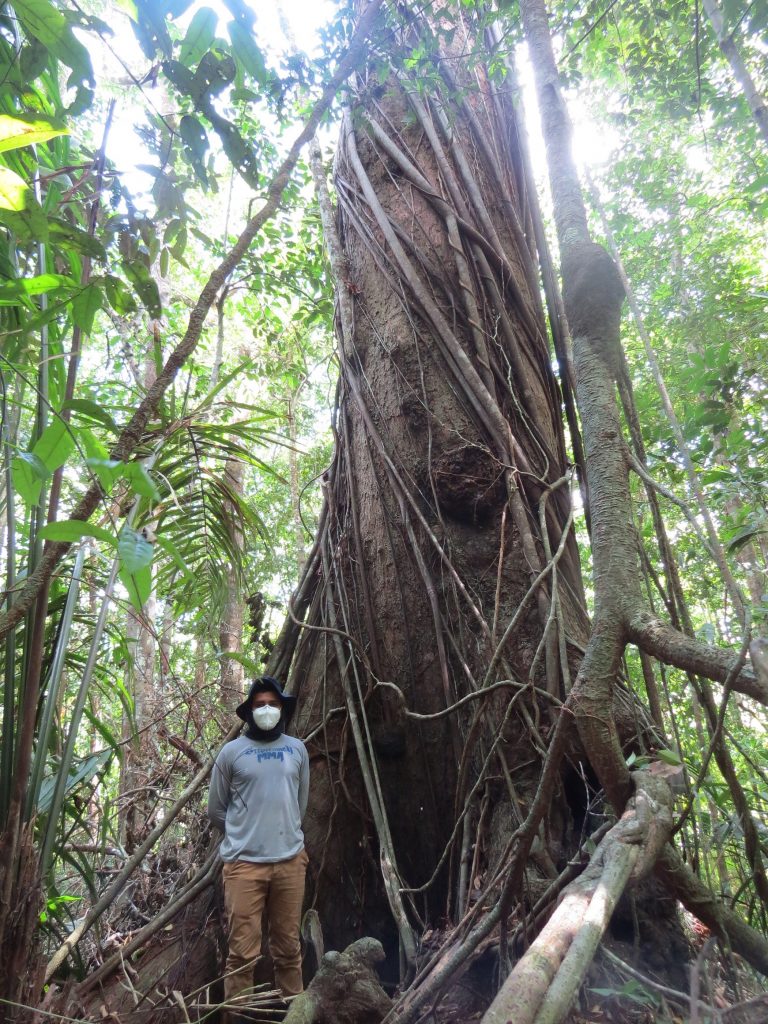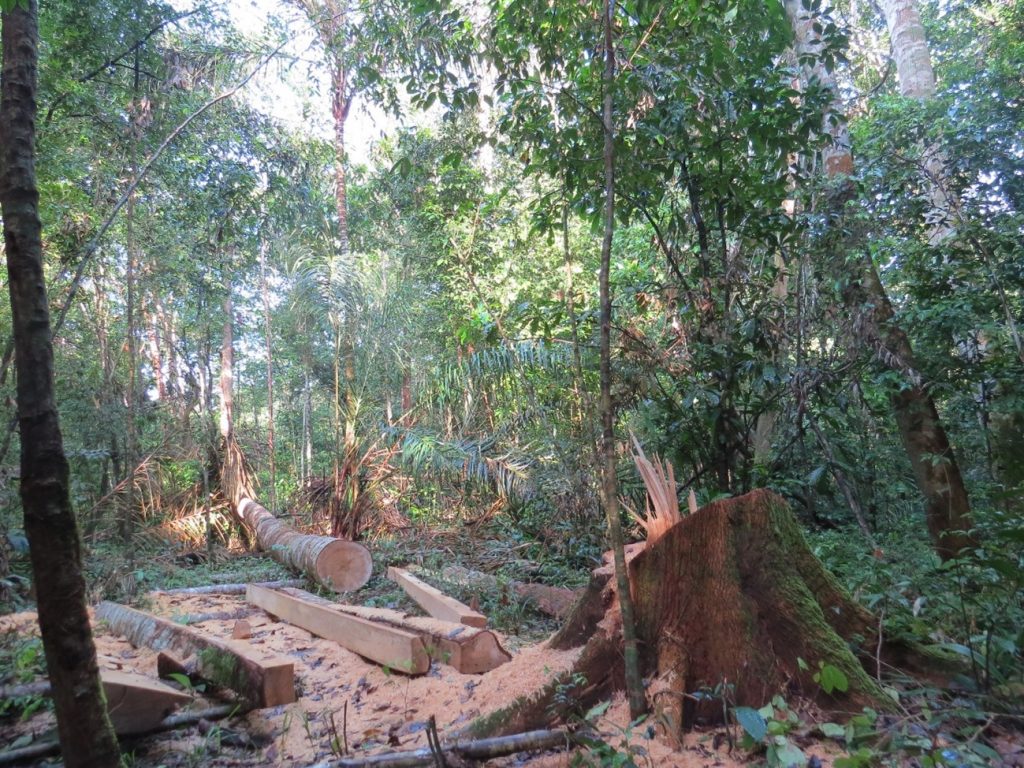
A mega-tree of the Amazon. Photo: Saulo Silvestre.
By Saulo Silvestre
Mega-trees are the largest trees on the planet.
They can live for hundreds of years, and tower over the surrounding forest canopies, making up only the top 1-5% of the tallest trees in their respective forests. Tropical forests, such as the Amazon, typically have fewer than five of these giants per hectare, which amounts to less than 10% of all trees. Mega-trees are keystone components that greatly support the biodiversity and ecosystem of tropical forests, but, despite their critical role, they are paradoxically vulnerable and face growing threats from human activities and climate change.
The tallest tree currently known is a redwood standing at 115.6 meters tall, situated in a moist temperate forest in California.
In comparison, mega-trees found in tropical forests tend to be shorter, with the current world record holder being a yellow meranti tree from Malaysia, standing at 100.8 meters tall. Because of their extraordinary dimensions, mega-trees create microhabitats that are utilized by a diverse array of organisms. Their twists, branches, and cavities are home to creatures like bees, frogs, and lizards. Their overwhelmingly high crowns provide unique conditions for air plants, like bromeliads, mosses, and orchids, while also providing safe shelters for flying and canopy-dwelling animals, like birds and primates.
Mega-trees play a crucial role in combating climate change by absorbing and retaining substantial amounts of atmospheric carbon dioxide, a greenhouse gas, in the organic matter of roots, trunk, branches, and leaves.
The organic matter, also called biomass, of a tree increases exponentially with the diameter of its stem. Therefore, despite their rarity, mega-trees account for at least 50% of the total plant biomass of the Amazon, which is responsible for 17% of the total amount of carbon stored within terrestrial plants in the world. Moreover, a single mega-tree can produce organic matter in one year that is equivalent to the biomass of an entire tree up to 20 cm in diameter.
Although research on the ecological roles of mega-trees is still in its early stages, data suggest that they play a significant role in controlling ecosystem functions through their influence over resource availability, hydrological conditions, and even the seasonal distribution of rainfall in a region. These ancient trees, with extensive root systems, also act as “mother trees” that provide nutrients and information, using biochemical signals, to other plants through mycorrhizal networks connecting the forest.
Mycorrhizal is a relationship between some types of fungi and plant roots where they work together to help each other. The fungus gives the plant nutrients like phosphorus and nitrogen, while the plant gives the fungus sugars it makes through photosynthesis. The fungus has long, thin parts called hyphae that can connect with other plants, making a network that can share nutrients and other important things. These relationships are important for many plants to grow healthy and happen in most places on land, like forests, fields, and grasslands.
Even though they play such a significant role in the forest ecosystem, these colossal living structures are arguably among the most vulnerable plants of the forest.
Most of the species of mega-trees are naturally rare and can exist only in limited areas with the necessary conditions for survival, making them particularly vulnerable to extinction. Furthermore, they are, frequently, preferred targets for selective logging.
Towering over surrounding trees, mega-trees are vulnerable to the stronger winds brought on by climate change, putting the trees at higher risk of breaking. To support their stem and root structures, mega-trees invest an enormous amount of energy, which leaves them with limited energy for producing leaves. This trade-off leads to reduced reproductive output and lower resistance to cavitation, a condition where the water coming from the roots cannot reach the top of the tree due to insufficient pressure. Under extreme drought conditions, this increases the risk of hydraulic failure for mega-trees.

Selective logging of a mega-tree in an Amazon forest. Photo: Saulo Silvestre.
Other species face similar threats to mega-trees, such as habitat loss and climate change, but mega-trees are particularly vulnerable due to their unique characteristics.
Habitat loss is the major current threat to tropical mega-trees, given the ongoing conversion of old-growth forests into human-modified landscapes. For instance, between August 2019 and July 2020, 11,088 km2 of the Amazon rainforest were deforested in Brazil, an area larger than the total area of Jamaica (10,991 km²). And since then things have become worse. According to Gabriel Araújo, in Reuters, preliminary official data show that, in February 2023, deforestation in Brazil’s Amazon rainforest increased at the highest rate ever recorded for one month, posing challenges for the new government’s efforts to halt destruction. The recent data showed 322 km2 were cleared in the region that month, a 62% increase from February 2022 and well above the average of 166 km2 for the period.
Even if a mega-tree is not logged in a deforested area, its chances of survival are severely diminished by the loss of the surrounding forest.
Being closer to forest edges, mega-trees experience disruptions to the plant-animal interaction networks that are responsible for pollination and seed dispersal. They also face increased wind impact and higher probabilities of severe droughts and wildfires.
Awareness of the importance and critical threats to mega-trees has significantly increased in recent years.
In the Amazon forest, ongoing research projects are targeting these giants, ranging from mapping the mega-trees of large areas through remote sensing to expeditions to remote regions to study these individuals. However, the future of mega-trees relies on protecting extensive tracts of old-growth forest and maintaining forest cover on a regional scale. Projects like ‘Forest for People’ by the United Nations Food and Agriculture Organization (FAO) provide examples of how productive forest landscapes can sustain local livelihoods with a high potential for economic development, while conserving the local biodiversity and ecosystem services. Initiatives like these offer hope for the future of mega-trees and, consequently, all the organisms they support, including humans.
Related links:
The Brazilian Amazon deforestation rate in 2020 is the greatest of the decade
Forests for food security and nutrition




I have 100 acres of forest that I am leaving untouched as a nature reserve. The crown land that surrounds my property is logged every 20 years with at least 1/3 of the mature trees harvested. I am observing the differences in animal and tree regeneration between the two parcels of land. The 100 acres was cleared in 1875 and replanted with fruit trees at that time. With very little soil this farm flailed after several years. Since then the property has regrown with a mixture of soft and hard woods.
It would be interesting to know how many trees have effectively been replenished by farm land returning to its natural state, in Canada. I recall reading some years ago that percentage of Canada in forest, is greater today than anytime since then1600’s (I am not sure how one would verify this).